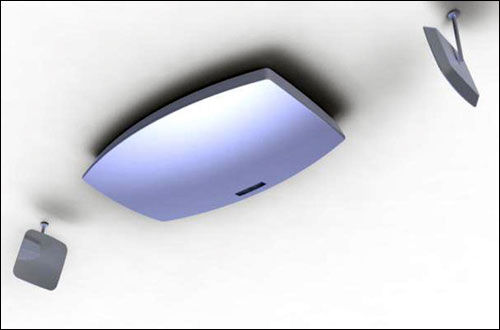Checkpoint Systems, a provider of electronic article surveillance (EAS) solutions, announced today that it is introducing a new anti-theft system in North America and Europe. The new solution employs passive radio frequency identification software from the company’s OATSystems division, as well as passive ultrahigh-frequency (UHF) RFID readers that utilize technology acquired when Checkpoint purchased California startup firm Wirama in 2009.
The new system, dubbed the RFID Overhead EAS Solution, features RFID interrogators installed on (or in) ceilings above doorways, to read RFID tags as they exit a store. Traditionally, EAS systems—and recently introduced RFID EAS solutions—have required the installation of antennas on both sides of a doorway, which can cause some degree of obstruction in the entrance and exit. However, says Per Levin, the president of Checkpoint System’s Merchandise Visibility Solutions division, Checkpoint’s reader, as well as its two separate antennas, are instead mounted overhead, where the device can capture an apparel label’s unique ID number anywhere within a doorway up to 4 meters (13.1 feet) in width.
The system also includes Checkpoint’s Merchandise Visibility software, built on OATSystems’ OAT Foundation Suite to manage data related to RFID reads at the doorway, and to forward that information to a user’s own management system.
The RFID Overhead EAS Solution is the latest of several systems provided by Checkpoint that employ RFID specifically for apparel stores, though it could also be suitable for other types of retailers as well. In September 2010, the company created its RFID-based inventory-visibility solution division (see Checkpoint Systems Creates RFID-centric ‘Visibility’ Division). In January of this year, the firm released an Electronic Product Code (EPC) numbering platform intended to simplify the process of using RFID labels at the item level (see Checkpoint Systems Launches EPC Numbering Service).
Checkpoint’s Merchandise Visibility software enables retailers using the RFID tags to manage the supply chain from manufacturer to store, and to track which products have been moved from the back room to the sales floor by means of RFID interrogators installed at key locations, as well as handheld readers for conducting inventory counts. In addition, Checkpoint offers a point-of-sale (POS) system with which items could be placed on a desktop reader and rung up according to the unique ID numbers on the garment labels. Finally, the RFID Overhead EAS system would detect if a person failed to purchase an item (at which time an RFID label would normally have been removed), and trigger an alarm, as well as send an update to the user’s inventory-management system, thereby indicating what had been removed from the store.
For example, if a tag were not disabled or removed from a garment (which, for a legitimate purchase, a sales clerk should do at the point of sale), that tag would also be read while passing through the exit. The overhead reader employs Checkpoint’s Wirama Radar hardware and software to determine not only a tag’s location, but also its direction of movement, by means of the device’s multiple phased arrays of antennas.
Checkpoint’s visibility software offers several options in response to each time that a reader interrogates a tag. It could send an update to the inventory data to the store’s enterprise resource planning (ERP) system, in order to indicate which item was removed, or it could trigger an alert, causing an alarm box provided by Checkpoint to flash a light and sound an audible alarm at the door. In addition, the software could send a text message to staff members. Finally, if a display screen were installed at the exit as well, the OATSystems software could transmit an item’s ID, linked to its stock-keeping unit (SKU) and descriptive details, to the store’s ERP system, which could then display the item or items being removed on the screen as the individual walked out the door. In that way, the person exiting the store, as well as store personnel, would know exactly what was being removed at the same time that the alarms were being triggered.
“Not necessarily one road map fits everybody,” Levin says. “We want to provide flexibility for our customers.” The system can also be designed to respond differently, according to whether or not an item is high-value. For example, it could be set to only sound an alarm and update the inventory system if a $10 item were removed, but issue alerts to management with regard to the removal of many high-value items.
According to Levin, the RFID Overhead EAS Solution would work with a variety of EPC tag form factors, including hangtags, sewn-in labels and hard security tags—the last of which might provide the greatest theft-deterrence since they can not be removed in a store except by employees at the point of sale.
As it developed the RFID-based EAS solution, Checkpoint Systems worked with German retail chain Metro Group, which is not an apparel retailer—but though initially designed for apparel retailers, Levin notes, the system could also be used by other types of stores. “We can provide the solution for other form factors as well,” he states, “although our target is apparel, luxury brands and mall-based stores.”
Levin declines to provide details regarding the Metro Group pilot. Checkpoint has worked with several apparel retailers in North America and Europe to test the system, he says, though none have agreed to be named. “We have tested intensely since Q4 of last year,” he reports.
Those using hard tags can remove the tags at the point of sale, and then send them to Checkpoint’s Total Quality Management sites (there are two facilities—one in Shanghai, China, the other in Spain), where the hard tags will be serviced and then returned to apparel manufacturers for reuse. In this way, the hard tags can be used to track products from the manufacturer through the supply chain.



